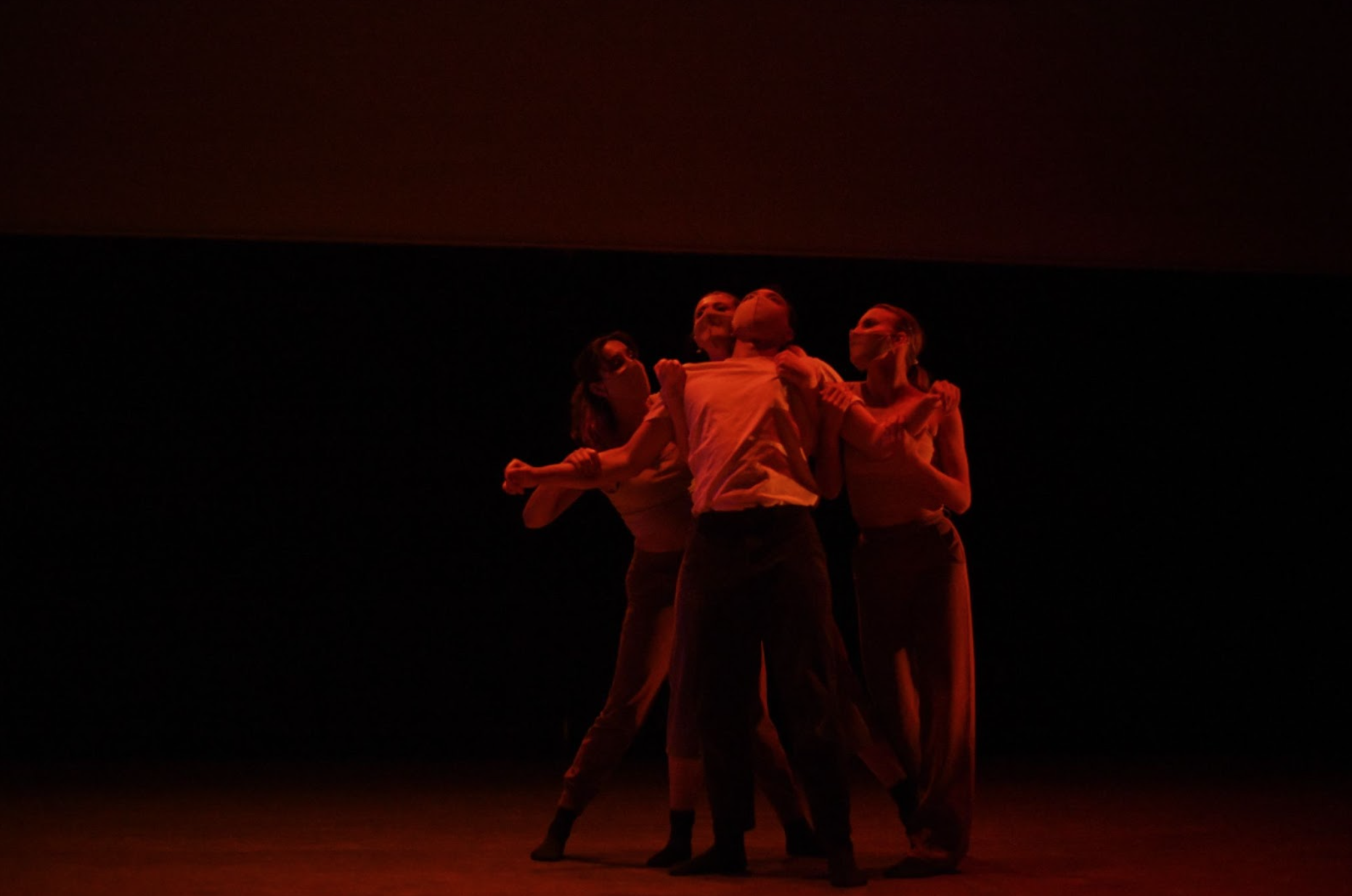Disrupting the stage’s darkness, a low light slowly illuminates five dancers all wearing brown pants and neutral-colored tops. The first dancer comes from downstage right — her body pushing and pulling towards the audience in a pray-like manner. Then, two dancers emerge from the center stage. Though their physicality initially appears connected and synced, they begin dancing away from each other in a circular motion as two other dancers step into the light, one from upstage and the other from stage left.
While their individual motions seem different, they share an unmistakable commonality. Each performer exudes equally elegant, rhythmic movements that breathe in time with the stirring and measured guitar strums of John Frusciante’s “Before the Beginning.” Slowly and seductively, the dancers flow in and out of view until a haunting steel-guitar note breaks their singular, organic pursuits, and a dark orange light floods the stage.
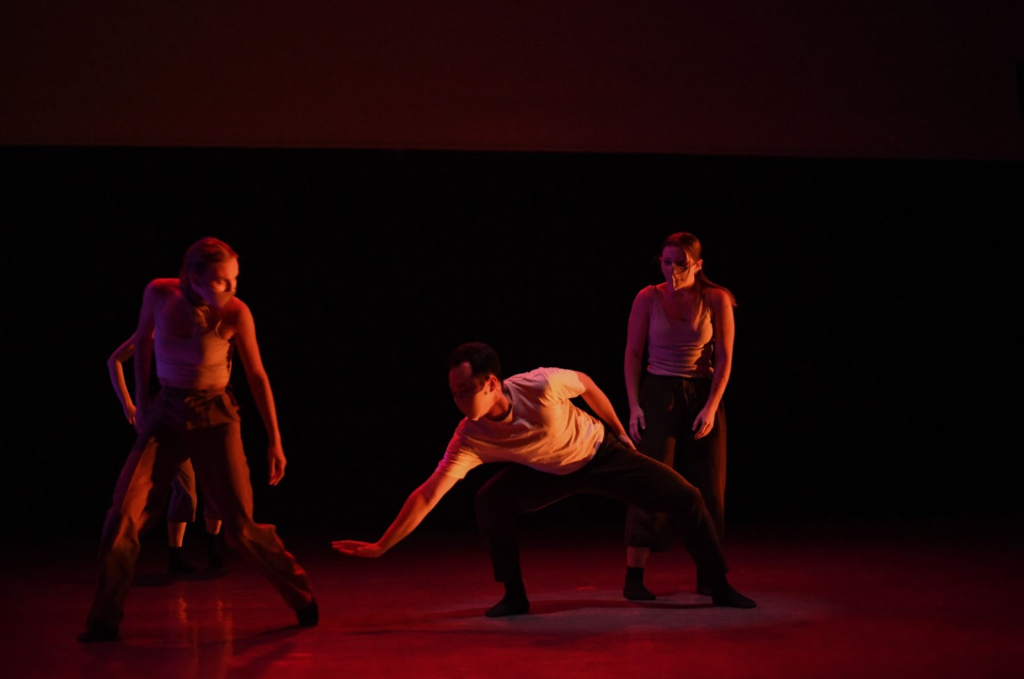
Now, cast in a flame-like glow, each performer dances gracefully, and yet, somewhat helplessly throughout, coming together around a single dancer in the center. Simultaneously, the lights dim — mimicking the performer’s brief connection to one another — before exploding into a sea of fire again as the dancers take to their separate spheres of the stage.
As distinct entities, the dancer’s cascade and drag across the floor, constantly ebbing between synchronized and singular, broken-down and strong, and fluid and rigid. At times, they seem to mimic each other’s posture, force and sameness. Comparatively, there is an overwhelming atmosphere of frustration and loneliness, indicated by the dancers’ tension and repetition, as well as their inability to completely coincide. Though three of the five often project the same motions, the pair in the center searches and scans the terrain separately, occasionally dropping to the floor in a distressed and somber position.
Finally, before the song’s end, four of the dancers unite on center stage for a final, curious image — the fifth having already floated out of sight. After nearly falling to the ground, the one male performer of the piece is grabbed and supported by the three remaining dancers, who lift him slowly onto his feet and into the light. With his arms outstretched towards either side of his body, his posture appears almost Christ-like–creating imagery that alludes to the crucifixion.
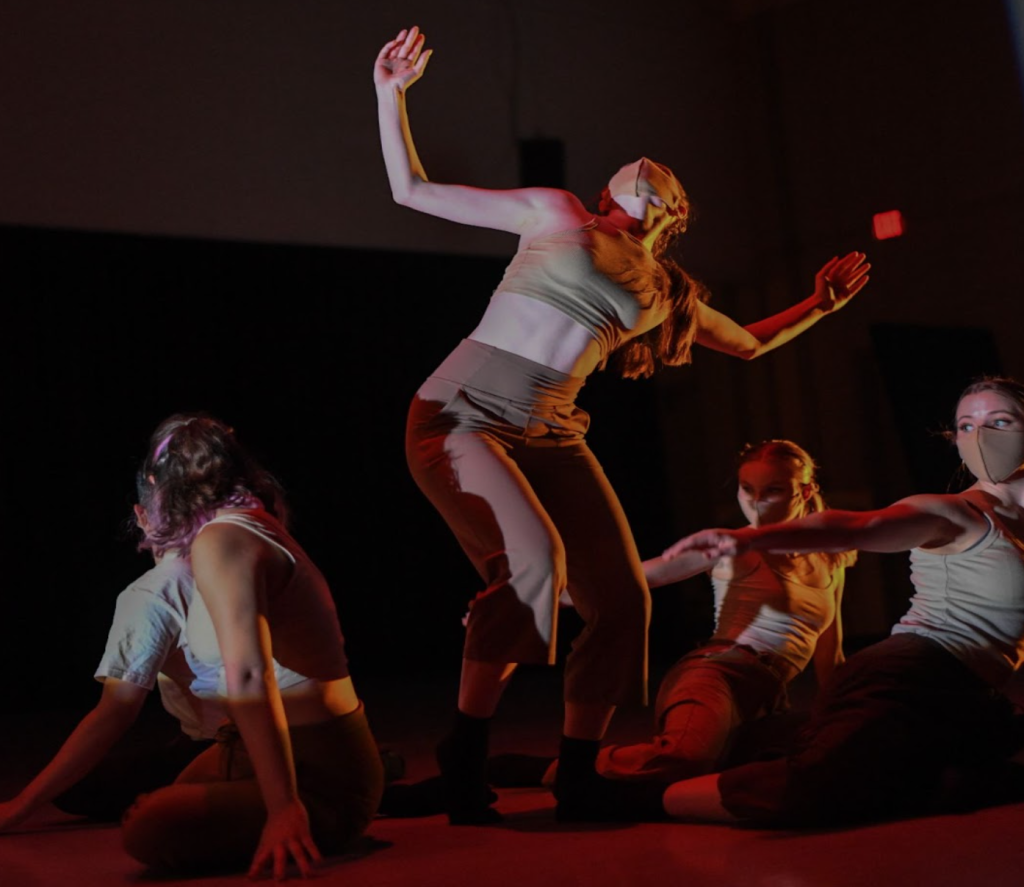
This is but a mere fraction of the beauty and multifaceted depth present within “Before the Beginning” — an enthralling piece choreographed by UCI fourth year student Paloma Perez-Rojas, who is from St. George, Utah.
Currently pursuing BFAs in dance performance, dance choreography and education, Perez-Rojas’s choreography premiered in Bare Bones Dance Theater’s 2022 annual showcase that was themed “Shifting Perspectives” and was performed at Claire Trevor School of the Arts’ PTSU 1100 facility on March 4 and 5.
Founded in 1987, Bare Bones Dance Theater (BBDT) is a UCI student-run non-profit organization that is supported by the Claire Trevor School of the Arts’ Dance Program, which allows dance and non-dance majors alike to come together in the pursuit of artistic excellence, creativity and growth. As articulated by the organization’s website, the foundation of BBDT relies on teamwork, performance opportunity, diversity and outreach. Additionally, BBDT’s annual showcase promotes collaboration amongst “undergraduate dancers, choreographers, production designers and the community” in order to make a “professional-quality theatrical experience.”
For Perez-Rojas, who is a first-time choreographer for BBDT’s 2022 annual showcase, the prospect of creating for the show brought exciting experiences and challenges. When considering how to go about choreographing for the show, BBDT’s attention to collaboration and imagination also spoke to Perez-Rojas’s artistic inventions and processes.
The concept for “Before the Beginning” initially spawned from Frusciante’s song itself, but not in the way one might expect. While choreographing to music creates “too much pressure,” Perez-Rojas shared, the overall “feeling of the song” sparked her inspiration.
“Sometimes it’s [a piece’s inspiration] about an idea … but this one came from the song. I just liked the feeling of it,” Perez-Roja said.
With her initial inspiration in mind, Perez-Rojas began developing the piece. Confident in the talent and creativity of dancers Gabija Vabalaité, Lauren Gold, Bridget Nagel, Lenard Glenn “LG” Malunes and Bela Depalatis, she used her role as a choreographer to help inspire and spark their imaginations through improvisation.
“I used a lot of images,” she said. “I would give them a painting and then ask them to divide the painting into four sections, and then make a story — a beginning, a middle, a climax and an ending.”
This summated into a phrase, a sequence of connected movements that relate to one another and project artistic or rhythmic continuity.
The dancers, which Perez-Rojas noted as collaborators and additional choreographers of the piece, would then share, compare and “learn each other’s movement.” This “brought so much content” that she could sculpt and design what “they had made into something that was visually pleasing” and fit the song’s atmosphere and music cues, which was added last.
For Perez-Rojas, the organicness of improv brought both surprise and wonder to the creation process. While the dancers would improv and “do the choreography either in pairs, apart, as a group, or copying each other,” she would watch their physicality — filtering out what worked best for the dance as a whole and filming it to remember the brilliant motions spawned from spontaneity.
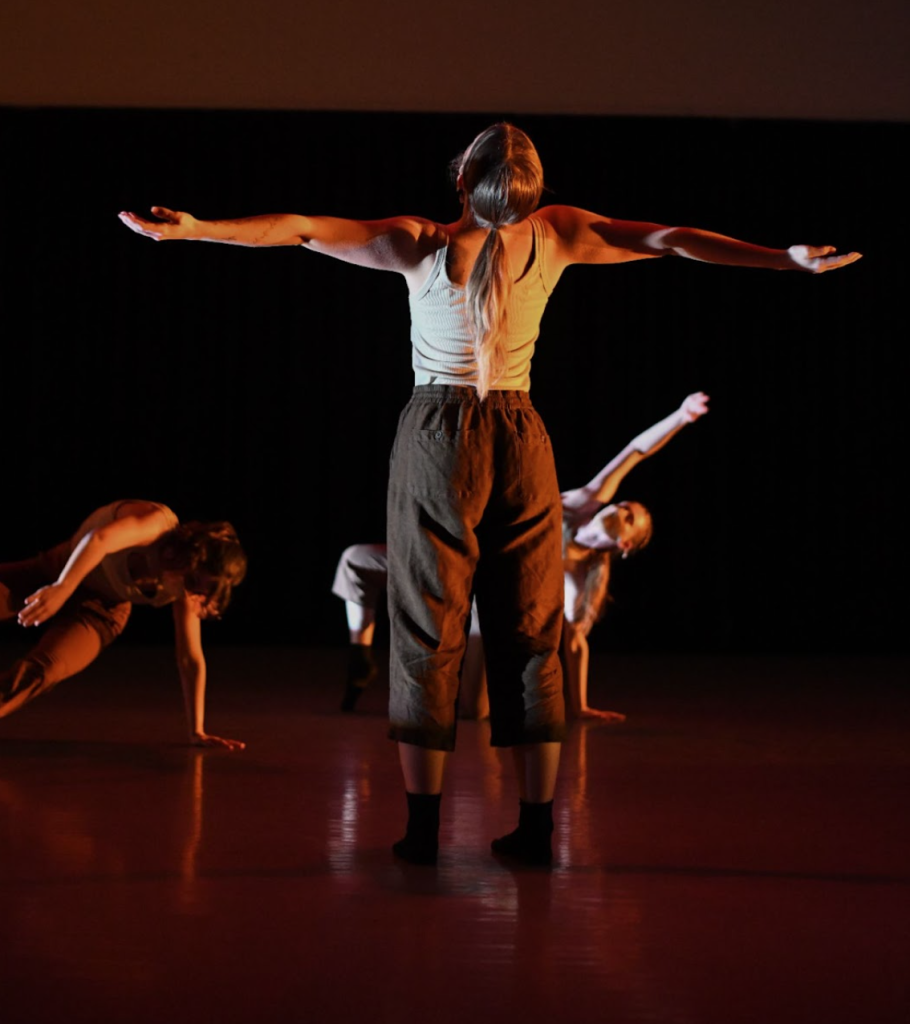
The improv aspect of choreographing was “fun because there were a lot of beautiful moments,” Perez-Rojas said. Preparation for her role as a choreographer also came in the form of watching and rewatching those impromptu videos, “but it would always change in rehearsal.” Excitingly and curiously to her, “[i]t would always be different than what [she] thought because it was improv, and then the piece just evolved into what it became.” Because of this, “inspiration came day by day, rehearsal by rehearsal” as new movements, ideas and feelings continued to elevate and evolve the piece as a whole.
Although this was her first-time choreographing for BBDT, Perez-Rojas currently works as an instructor for dancers ages five-13, where she often takes on the role of choreographer in addition to teaching. This and her background studying education brought attention to the creative atmosphere of the piece’s rehearsals and intentionality to its choreography.
For instance, while the song wasn’t added officially until after the choreography was completed, Perez-Rojas kept the essence of the song and its euphonious musicality in mind.
“Something I also tried to ensure … was creating an environment within the room that was based on the song,” Perez-Rojas said.
Much like she’d do within her teaching position, she’d ask herself “How can I,” considering “the way the song feels, make the room feel like that?” By considering the mood, atmosphere and overall vibe of the music throughout the creation process, it ensured that “whatever choreography and improv” her dancers invented always had “the roots of that song” in mind.
The finished performance was sure to evoke emotions within those observing it, though the exact emotion need not be crystalline or singular in Perez-Rojas’ opinion.
Originally, she believed the choreography would exude a feeling of heartbreak that Perez-Rojas was experiencing herself at the time; however, she knew through continued rehearsals and her own healing process that she “didn’t want to make a piece about heartbreak, really.” Rather, she “wanted to see how the piece would evolve on its own.”
“That’s why I tried to be as open, in each rehearsal, to whatever was going to happen, rather than plan out what I wanted to happen,” Perez-Rojas said.
Organicness and authenticity are of utmost importance, rather than a pre-planned vision.
Some audience members may have noticed imagery of inner turmoil vs. outer presentation, refined vs. organic and grace vs. distress present in “Before the Beginning.” Others may have felt emotions like condemnation, guilt, shame and blame within the piece, as well as allusions to ancient art and the crucifixion of Christ, which both Perez-Rojas and the dancers themselves initially assumed the dance would exude.
Her own take-away from the final choreography and completed work stirred feelings of
“contemplation and solitude in a way that [felt] heavy, difficult and treacherous.”
“It’s like sitting in a room at like 8 p.m., and you’re just not feeling so great; but it’s not dramatic, it’s just super real,” Perez-Rojas said when offering an image of her original interpretation of the dance. “It’s so real that it’s just a human on a couch with wrinkles, kinda smelly [and] not really caring about the posture … They’re just not in the best state. But it’s not anything dramatic, it’s just kinda vulnerable.”
However, Perez-Rojas believes the piece’s message, themes and overall emotion are less definable and more universal. While the vulnerability she describes is undoubtedly present, she ultimately let all of her preconceived notions on the dance go, “so that the piece could just become what it was.”
Eloquently, she said, “[i]t means whatever it means, but it has a feeling that is human.” That humanness is “why the audience understands it. It’s not really something that makes sense from beginning to end, and maybe if it does, it does, but it’s just important to me that they feel something.” She added, “humans watching humans is going to naturally create a feeling,” though this feeling remains for each individual watcher to discover for themselves.
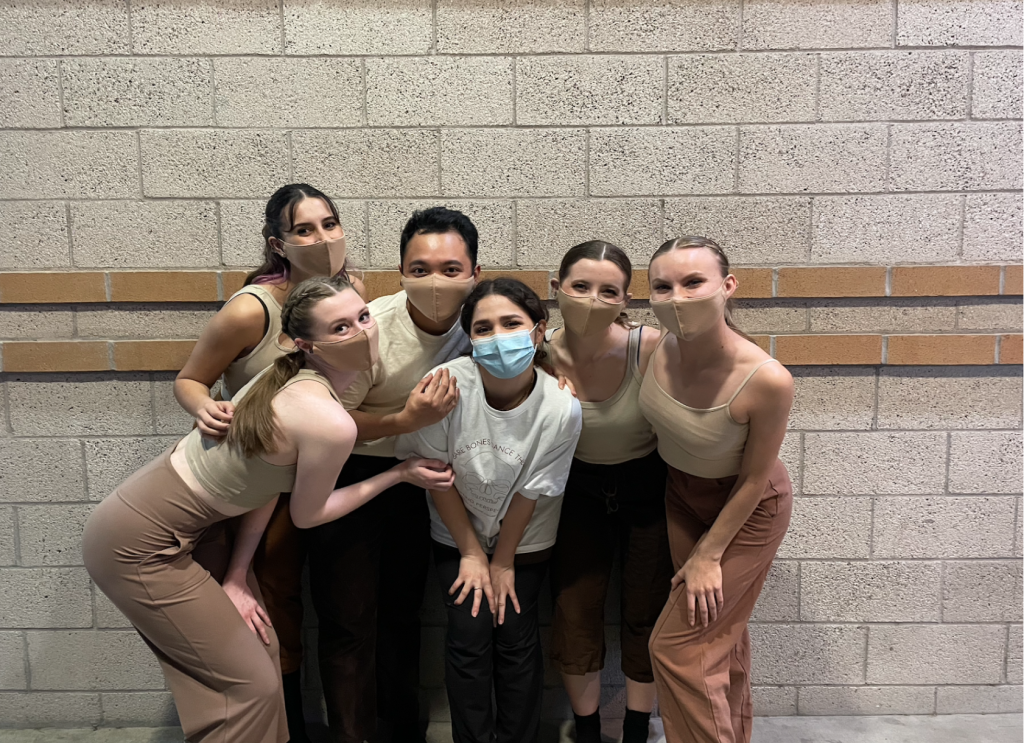
In line with the terrific and moving choreography and dance as a whole that Perez-Rojas produced, her biggest take-away from the experience comes from the collaboration BBDT permits. For Perez-Rojas, the richest part of the process was the community aspect–fellow choreographers, friends, dancers and her roommates all supported her work and helped shape the piece into what it is today. Above all, she wants her dancers to know how much their participation and dedication mean to her as a choreographer and their friend.
Passionately she concluded with the heartfelt message that if her BBDT community and dancers Vabalait, Gold, Nagel, Malunes and Depalatis were to read this article, “they’d be happy to know that one of the most fulfilling parts of the process was their support and friendship.”
A true storyteller through movement, Perez-Rojas’ “Before the Beginning” was inspiring and stunning. It radiated humanness and depth that was both moving and impressive — thanks to the extensive talent of the dancers who bring it to life. Even as a first-time choreographer for Bare Bones Dance Theater, she has undoubtedly marked herself as a talented visionary and creative as well as a memorable choreographer. With grace and authenticity perfect for collaboration, it is certain Perez-Rojas will continue to create exceptionally powerful work, making her a great representation of UCI’s academic and artistic excellence.
Clairesse Schweig is Entertainment Staff Writer. They can be reached at cschweig@uci.edu.


